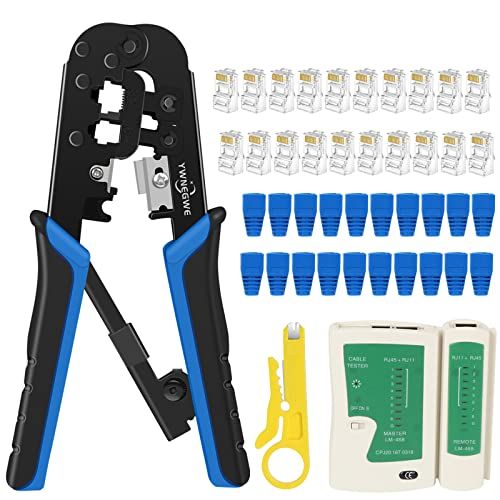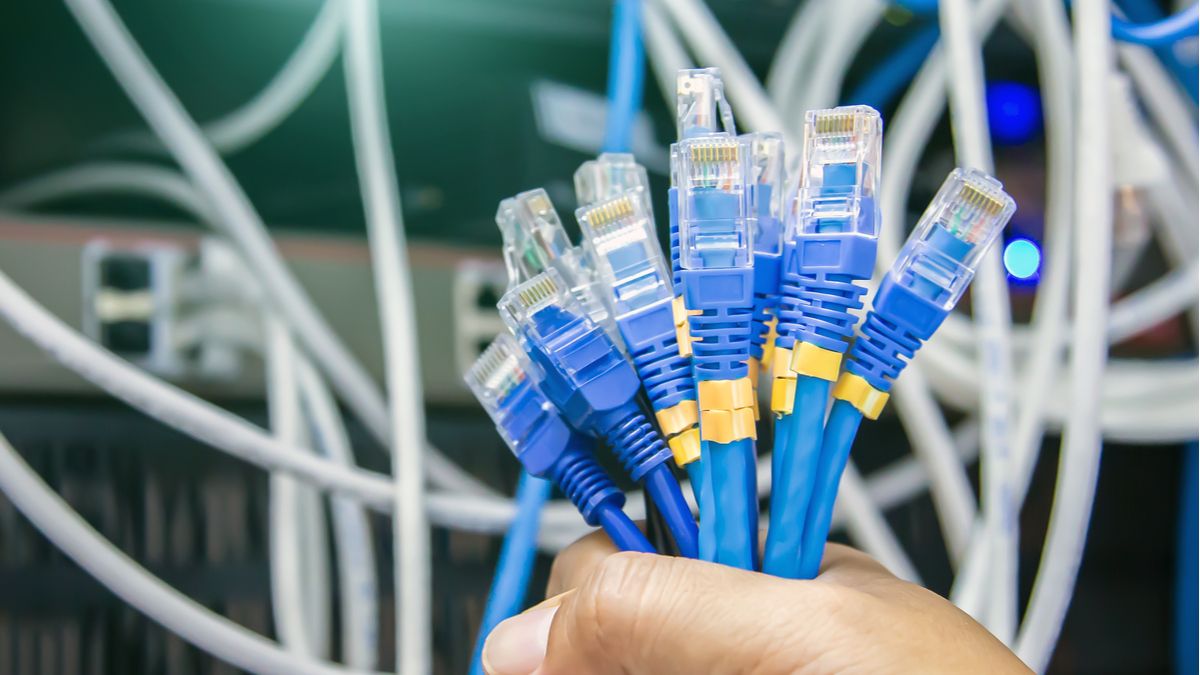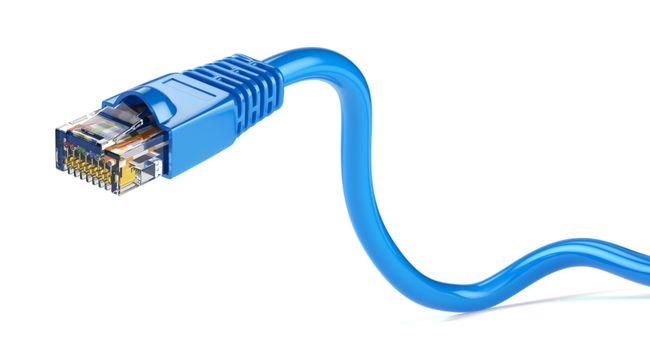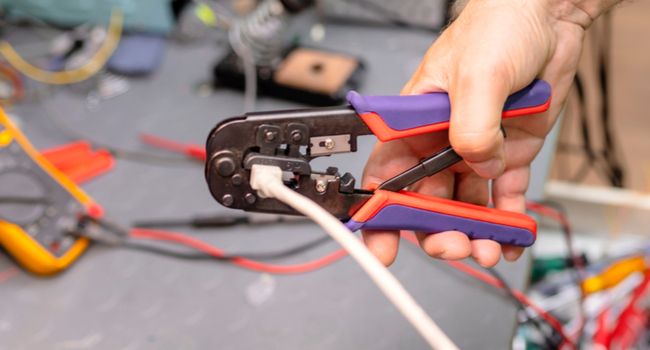Quick Links
Choosing an Ethernet cable is for the most part relatively straightforward. However, there are some things to keep in mind if you want to get the most out of your internet and local network connection.
Not All Ethernet Cables Are Equal
Wired networks are generally very simple to use. Most of the time, you plug the cable into the Ethernet port or adapter on your computer and you're good to go. Purchasing an Ethernet cable can seem far more complicated, with many different standards, speeds, and specifications to account for.
Network cables are separated into different categories, with the base standard being Cat-5. Just like different Wi-Fi standards, different Ethernet cable categories are capable of different speeds. The different categories available are:
- Cat-5 with a maximum speed of 100Mbps, typically unshielded.
- Cat-5e with a maximum speed of 1Gbps, available in both shielded and unshielded varieties.
- Cat-6 with a maximum speed of 10Gbps for runs under 55 meters (around 180ft), available in both shielded and unshielded varieties.
- Cat-6a with a maximum speed of 10Gbps, shielded.
- Cat-7 uses a proprietary GG45 connector rather than the standard RJ-45 connector seen on other cables for speeds of 10Gbps, shielded.
- Cat-8 with a maximum speed of 25Gbps (Cat-8.1) or 40Gbps (Cat-8.2) at a distance of around 30 meters (around 100ft), shielded.
Unless stated, these standards are typically rated at their quoted speeds for a run of around 100 meters (around 330 ft) and use a standard RJ-45 Ethernet connector. Each generation of cable is designed to be compatible with the generations that came before it, so it's possible (for example) to use a Cat-6a cable with a router that only supports speeds of 1Gbps.
Match Your Cable to Your Network and Usage
Let's say you're looking to install a simple wired networking setup in your study, a room where you already have your router and computer. You're doing this because you want the fastest and most efficient network to cover a small distance. You don't use network drives or copy large files across the network between other machines.
The first thing to check would be the speed of your internet connection, as well as which router you have and what speeds it supports. If your router is capped at a 1Gbps maximum, there's no point springing for a Cat-6 or faster cable since Cat-5e matches the maximum throughput of your router.
But if you have a router that supports 10Gbps networking, and you're fortunate enough to have an internet connection that exceeds 1Gbps, then you'll want to buy a Cat-6 or better to get the most out of your hardware and connection. You should have some idea of your theoretical maximum internet speed from your ISP, and your router is likely to have its maximum Ethernet throughput written on the box or the back of the unit.
In another scenario, you might be wiring your whole apartment in the hope to connect several computers and media devices. You're interested in streaming high bandwidth video locally over the network, accessing large project files from a central network drive, or other network-intensive tasks. In addition to investing in a heavy-duty router that can handle 10Gbps (or better) networking, Cat-6a or even Cat-8 cable should be up for consideration.
If you want to future-proof yourself and upgrade your network equipment at a later date, you might want to run the fastest network cable you can afford (or justify) at the time, since replacing the cable at a later date might end up costing you more.
Shielded or Unshielded?
You may not get a choice between shielded and unshielded cables, depending on which standard you go for. Most Cat-5e cables are available in both shielded and unshielded varieties, with benefits and drawbacks to each.
Shielded cable is often referred to as Shielded Twisted Pair (STP). These cables are designed for environments with lots of electromagnetic interference, such as power lines, wireless networks, or environments where radio waves are more common like universities or TV studios.
Due to how tightly bound the cables are, these kinds of cables are more rigid, thicker, and require grounding. It's also more expensive due to the additional materials and processes.
Unshielded cables, or Unshielded Twisted Pair (UTP) cables, are more suitable for environments with less cross-talk or noise. This includes most homes and small businesses. These cables are more flexible and easier to work with, smaller, and cheaper to buy and manufacture.
The grade of cable you purchase can also make a difference. Higher grade cables operate at faster speeds and higher frequencies (Cat-5e operates at 100MHz, while Cat-6a runs at 500MHz) which are more susceptible to interference. This is one of the reasons that faster cables are more expensive.
Copper Purity and Signal Loss
Ethernet cables transfer a network signal using copper, a highly conductive and common material that's been used for telecommunications since the earliest phone lines. The quality of the copper used is often indicative of signal quality, and this is reflected in the price.
Cheaper cables may only use copper-clad aluminum which may suffer from a higher rate of signal loss over time since the aluminum expands and shrinks as it warms and cools. Pure copper is more stable, durable, and highly conductive but there are even considerations within this realm.
Oxygen-free copper wire is made from more than 99.95% pure copper, with fewer impurities like oxygen and iron than a standard pure copper wire which may "only" be 99.5% pure. How much of a difference this makes in the real world is hotly debated, particularly among audiophiles when discussing speaker wire. While having a purer copper backbone means fewer "hurdles" for your signal to travel through, having a pure copper wire in the first place is arguably the most important target to aim for.
Gold and RJ-45 Connector Plating
Gold is frequently used in connectors for all sorts of connections, from 3.5mm stereo jacks to HDMI cables. There's one clear advantage that gold has over other metals: a low oxidization rate. While silver may be more conductive, gold will oxidize at a slower rate which means better longevity. This is why most RJ-45 connectors will use gold plating.
Something to note is the thickness of the gold used on the end of the connector, especially if you're going to be removing and reconnecting the cable regularly. Higher quality cables will use thicker gold plating, which will wear out at a slower rate.
This plating is measured in microns, with 50 microns being the optimal thickness. You should ideally look for this number quoted on the box or in the item description to ensure your cable is of high quality.
Consider Rolling Your Own Network Cables
If you're the DIY type you might be interested in making your own network cables. Having the tools and parts to do this ensures that you can fix broken connectors, trim frayed ends, and create cables that are precisely as long as you need them. This will cost you more than a standard cable to begin with, but will probably work out cheaper over time.
For this, you'll need a length of whatever network cable category you are using (for example, Cat-6), modular connectors (RJ-45s), and a crimping tool for cutting and finishing your cable. These are often available in crimping tool kits (like this one) minus the cable. You'll also likely want to get your hands on a cable tester, just to make sure that each cable you roll is configured correctly.

RJ45 Crimping Tool Kit Ethernet Crimp Tool Set, RJ-11, 6P/RJ-12, 8P/RJ-45 Crimp, Cut and Strip Tool with 20PCS RJ45 CAT5 CAT5e Connectors, 20PCS Covers,1 Network Cable Tester and 1 Wire Stripper
Roll your own network cables with this cheap and cheerful crimping tool kit, ideal for use with Cat-5 and Cat-5e cable (which you'll need to buy separately).
Don't Forget Wi-Fi Too
Even though wired networking is the most reliable and simple way of connecting many devices to the internet, the modern smartphones and tablets that have taken over many of our daily tasks heavily rely on Wi-Fi.
Make sure your wireless network is up to task and that you're using a high quality wireless router to cover all of your bases.



